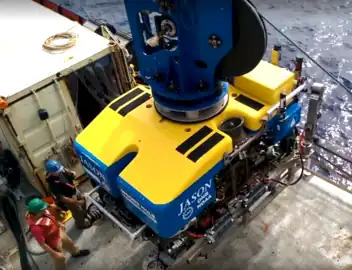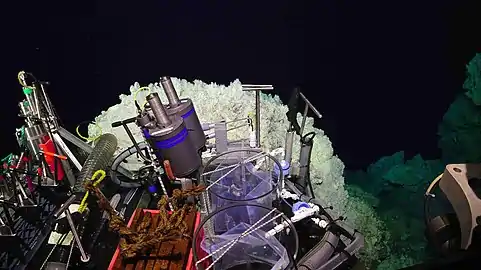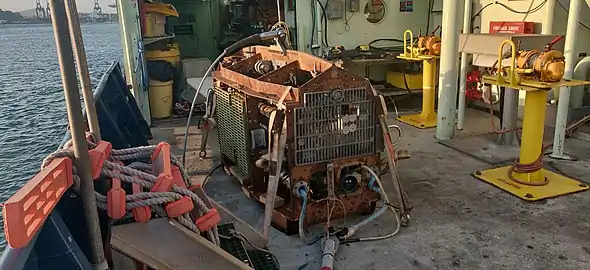 A rear-view of Jason and the deployment arm on the R/V Atlantis in 2020 | |
| History | |
|---|---|
| Name | Jason |
| Builder | WHOI |
| General characteristics | |
| Tonnage | 4.5 tons |
| Length | 3.4 m (11 ft 2 in) |
| Beam | 2.2 m (7 ft 3 in) |
| Height | 2.4 m (7 ft 10 in) |
| Propulsion | Six brushless DC thrusters each providing 250 lbf thrust |
| Speed | 1.5 knot forward, 0.5 knot lateral, 1.0 knot vertical |
| Endurance | theoretically indefinite |
| Test depth | 6500 m |
| Sensors and processing systems | Attitude
Two-axis clinometer, 0.1 degree resolution Heading Flux-gate compass, 0.1 degree resolution Gimballed gyro, 0.1 degree resolution Pressure Depth Bulk semiconductor strain gauge, 1m resolution Altitude 120kHz updating at 2Hz, 33 meters range, 0.1 m resolution |
| Notes | Video
Two surface-selectable channels from the following: One single-CCD-chip color One three-CCD-chip color One single-CCD-chip black and white, aft looking Still Camera 35mm, 400 frames with either 16mm or 28mm lens Electronic Camera Marquest Model 9100 camera Lighting One 200 watt-second strobe One 300 or 600 watt-second strobe Three 250 watt incandescent lamps Two 400 watt HMI lights SImagenex 855 scanning sonar with forward imaging or profiling head Payload: 50 kg Umbilical: 35 meters, 18 mm diameter, neutrally buoyant Navigation Long base line responder or relay transmitter/receiver 7-12kHz vehicle powered or battery operated for emergency location |
Jason is a two-body remotely operated vehicle (ROV) designed, built, and operated by the National Deep Submergence Laboratory of the Woods Hole Oceanographic Institution (WHOI). Construction of Jason began in 1982 and was first launched in 1988, redesigned in 2002 as the second iteration of the ROV (Jason II).[1] The ROV allows scientists and explorers to have access to the seafloor without leaving the deck of a ship.
As of 2020, Jason has completed 147 cruises with over 1200 dives and over 16,000 hours of dive time.[2]
Construction and Equipment
Development on Jason/Medea began in 1982, with the goal of removing constraints of human operated vehicles such as Alvin.[3] Alvin only had 3-4 hours of time on the seafloor, required extensive and expensive planning for safety purposes, and required a sophisticated handling system for such a large vehicle.
Jason's original commission was in 1988, with a deployment at Hood Canal in Washington state, USA. The first-generation of the ROV was involved in over 200 launches until its retirement in 2001.[1][2] The second-generation ROV, called the Jason II, had its sea trials in July 2002 at Nubbin Seamount in the Cascadia basin.[2] In 2016, Jason was upgraded with a new frame, tether, recovery system, and skids that increased the payload by several thousand pounds.[1][4]
A 10-kilometer (6-mile) electro-optical-mechanical tether delivers electrical power and commands from the ship through Medea and down to Jason, which then returns data and live video imagery. Medea serves as a shock absorber, buffering Jason from the movements of the ship, while providing lighting and a bird’s eye view of the ROV during seafloor operations.[4][5][6]
Jason is equipped with sonar imaging as well as video, still, and electronic cameras and appropriate lighting gear. It carries precision navigation equipment and sensors for depth, vehicle attitude (tilt), and altitude from the seafloor. Jason's manipulator arms can collect samples that may be put in a small basket attached to the vehicle or, for heavier items, on an attached "elevator" platform that carries them to the surface.
Jason, while not requiring an entire ship for operations, does require modular workshop and control vans for operations and maintenance on any vessel.[3] In addition, the ROV requires an overboard handling system such as a crane or A-frame, winch system, and data center be installed on the vessel.
Trivia
A prototype of Jason called Jason Jr. was used with Alvin to explore Titanic in 1986.[7] Jason Jr. was lost at sea in 1991.
Jason and Medea were named after the married characters of Greek mythology.[8]
In late summer 2021, two other ROVs, Hercules and Argus, were lost when the ship tether broke while deployed off the coast of Victoria Island. Jason happened to be fewer than 200 miles away, and managed to recover them within 24 hours of arriving at the other vessel.[9]
Gallery
 Jason arm samples fluid at the West Mata undersea volcano
Jason arm samples fluid at the West Mata undersea volcano The interior of the Jason Operations van in 2020
The interior of the Jason Operations van in 2020 Jason deploying at Axial Seamount in 2017
Jason deploying at Axial Seamount in 2017 Jason's sampling basket, filled with scientific equipment
Jason's sampling basket, filled with scientific equipment.jpg.webp) A fish swims by Jason's manipulator arm
A fish swims by Jason's manipulator arm Medea on deck, the intermediate between Jason and the host research vessel
Medea on deck, the intermediate between Jason and the host research vessel
References
- 1 2 3 US Department of Commerce, National Oceanic and Atmospheric Administration. "Remotely Operated Vehicle Jason/Medea: Technology: Submersibles: Vessels: NOAA Office of Ocean Exploration and Research". oceanexplorer.noaa.gov.
- 1 2 3 "Dive Log – Jason". National Deep Submergence Facility.
- 1 2 Ballard, Robert D. (1993-08-01). "The MEDEA/JASON remotely operated vehicle system". Deep Sea Research Part I: Oceanographic Research Papers. 40 (8): 1673–1687. Bibcode:1993DSRI...40.1673B. doi:10.1016/0967-0637(93)90021-T. ISSN 0967-0637.
- 1 2 US Department of Commerce, National Oceanic and Atmospheric Administration. "DEEP SEARCH 2019: DEEP Sea Exploration to Advance Research on Coral/Canyon/Cold seep Habitats: All About ROV Jason: NOAA Office of Ocean Exploration and Research". oceanexplorer.noaa.gov. Retrieved 2022-01-28.
- ↑ "Remotely Operated Vehicle Jason/Medea". NDSF Vehicles. WHOI. Retrieved 17 January 2012.
- ↑ "ROV Jason 2". ooicruises.ocean.washington.edu. Retrieved 2022-01-28.
- ↑ Ballard, Robert (2008). Archaeological Oceanography. Princeton: Princeton University Press. pp. 102, 104. ISBN 978-0-691-12940-2.
- ↑ "ROV Jason/Medea - Woods Hole Oceanographic Institution". whoi.edu/.
- ↑ "ROV 'Jason' Helps Recover Two Other Underwater Vehicles". www.hydro-international.com. Retrieved 2022-01-28.